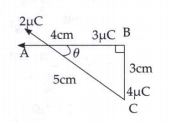Three charges of 2μC,3μC and 4μC are placed at points A, B and C respectively, as shown in Fig. a Determine the force on A due to other charges.
 Solution in Marathi
Solution in Marathi
Step by step video & image solution for Three charges of 2muC, 3 mu C and 4 mu C are placed at points A, B and C respectively, as shown in Fig. a Determine the force on A due to other charges. by Physics experts to help you in doubts & scoring excellent marks in Class 11 exams.
Updated on:21/07/2023Topper's Solved these Questions
Similar Questions
Which types of waves are used in different Electronic gadgets?
View SolutionState Kepler's Laws of planetary motion.
OR
State kepler's law of orbit and law of equal areas.
OR
Any one law can be asked for
OR
State Kepler's law of equal areas.
OR
State Kepler's Law of period.
View SolutionA point charge μ is placed at origin. Let →EA,→EB,and→EC be the electirc field at three points A (1,2,3), B (1,1,-1), and C(2,2,2) due to charge μ. Then
View SolutionFour point charges qA=2μC,qB=−5μC,qC=−2μCandqD=−5μC are located at the corners of a square ABCD of side 10 cm. What is the force on a charge of 1μC placed at the center of the square ?
View SolutionCharges of +5μC,+10μC and −10μC are placed in air at the corners A,B and C of an equilateral triangle ABC, having each side equal to 5 cm. Determine the resultant force on the charge at A.
View SolutionThree point charges are placed at the following points on the x-axis : 2 mu C " at " x=0, -3 mu C " at " x=40 cm " and " -5 mu C " at " x=120 cm. Calculate the force on the -3 mu C charge.
View SolutionTwo point charges of +1.5 mu C " and " -1.5 mu C are placed at the corners A and B of an -6 mu C placed at the third corner of the triangle ?
View SolutionTwo point charges 5μCand10μC are separated by a distance 'r' in air. If an additional charge of −4μC is given to each, by what factor does the force between the charges change ?
View SolutionDetermine the potential at a point 0.50 m (i) from a+20μC potential charge (ii) from a−20μC point charge.
View SolutionThere are two point charges +4 mu C and -2 mu C .The ratio of magnitude of electrostatic forces acting on them respectively will be
View SolutionElectrostatic force experienced by −3μC charge placed at point 'P' due to a system 'S' of fixed point charges as shown in figure is →F=(21ˆi+9ˆj)μN.

If now 2μC charge is placed and −3μC is removed at point P then force experienced by it will be.
View Solution[" 4.Four point charges "q_(A)=2 mu C" and "q_(B)=-5 mu C,q_(C)=],[2 mu c" and "q_(D)=-5 mu c" are located at the corners of a "],[" square "ABCD" of side "10cm" .What is the force on a "],[" charge of "2 mu c" placed at the centre of the square? "]
View SolutionThree point charges of 3 mu C, 4 mu C, and 5 mu C are arranged at the three corners of a right angled triangle ABC as shown in the figure. The work done in moving the charges at A and C, so that the three charges are located at the three corners of an equilateral triangle of side 3 cm is
View SolutionABC is a right triangle in which AB = 3 cm, BC = 4 cm and right angle is at B. Three charges +15μC+12μC and −20μC are placed respectively at A, B and C. The force acting on the charge at B is
View SolutionFour point charges qA=2μC,qB=−5μC,qC=2μCandqD=−5μC are located at the corners of a square ABCD of side 10 cm. What is the force on a charge of 1μC placed at the center of the square ?
View Solution
